Perhaps in this decade of centenaries, the National Museum of Ireland is an institution whose collections and role in contemporary society are both more contested and more ambiguous than at any other point in its history. This is evidenced by the extent to which its programming since 2013 has attempted to cater to the conflicting historical narratives which characterise the public perception of Irish history. While the museum’s 2014 exhibit on the Battle of Clontarf attempted to paint a more nuanced picture than the old story of ‘native Gael versus Viking invader’, the current 1916 exhibit has also sought to present a more all-encompassing narrative than previously, incorporating more traditional nationalist as well as revisionist viewpoints. In addition, although the title ‘National Museum of Ireland’ implies the existence of a monolithic institution, its various branches retain their individual character. Testament to this is the Archaeology branch’s celebration of its 125-year anniversary in 2015 while the Natural History Museum celebrated its own 160-year anniversary in 2017. It is the existence of these competing identities within the one institution which gives credence to the words of the Museum’s former director, Dr Patrick Wallace:
‘…to understand the National Museum of Ireland both as an institution and in terms of tradition from which its collection evolved, is in some ways to understand the complexity of modern Ireland itself.’
While Wallace seems to suggest that these complexities are uniquely modern, and thus stem from the political and cultural identity crisis characteristic of Ireland post-independence, these anxieties in fact have their roots in the earliest beginnings of the national collection and the academic societies of eighteenth- and nineteenth-century Dublin. It has been written that in studying Irish history, ‘our historians have felt more comfortable in discussions of banking, battles and bishops than in dealing with problems concerning basalt, binomials and brachiopods.’ Indeed the historiographical attention given to Ireland’s political and cultural developments, contrasted with that afforded to its scientific endeavours, would at first seem to imply that the study of Ireland’s political and cultural history and the study of its scientific history are disciplines so divorced from one another that they warrant exclusively independent study.
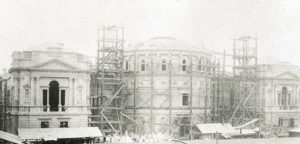
Yet the National Museum of Ireland, as both a cultural and scientific institution, was itself founded at the nexus of these ostensibly disparate fields. Historians have expressed a certain consensus that the former institution owes its existence largely to foundations laid by the Royal Dublin Society (RDS) and the Royal Irish Academy (RIA). One can fully appreciate the tensions and ambiguities which lay at the very roots of the National Museum’s establishment through analysis of these two institutions. With the scientific endeavours of the RDS and historical and cultural concerns of the RIA, the National Museum was founded on these twin pillars of scientific and historical significance.
Founded as materialisations of Enlightenment philosophy in Ireland, these societies were made up largely of members of the Irish Protestant Ascendancy, and both received royal patronage shortly after their establishment. However, while the learned gentlemen of the Ascendancy who made up these societies’ membership would certainly have been confident of their British identity, their affiliation to the RDS and RIA also served to further their interestin Irish agricultural and cultural affairs. The Ascendancy character of these societies and their contribution toward the establishment of the National Museum can be considered one of the main sources of tension and political ambiguity surrounding its foundation. Only by examining the activities of these societies over the course of their history and their contrasting motivations for the acquisition and display of their respective collections, can one fully understand their impact on the political and cultural character of the National Museum of Ireland from its beginnings under British rule into the post-independence twentieth century.
The Royal Dublin Society
To begin with the RDS, this institution owed its foundation to one Thomas Prior, who was inspired to establish the Society having been influenced by the seventeenth-century Dublin Philosophical society. This latter society had itself been founded by one William Molyneux, who had published his famous political work The Case of Ireland’s being Bound by Acts of Parliament in England Stated in 1698. In this book, Molyneux had argued that after five hundred years of British parliamentary governance, Ireland had irrefutably established its right to a separate parliament and independent legislature. Though denounced as dangerous at the time of publication, Molyneux’s sentiments found a new and more receptive audience as a sense of colonial nationalism began to develop among Irish Protestants during the next century. In light of this, one cannot fail to note the importance of Prior’s affinity for Molyneux’s views. It suggests that Prior himself regarded Ireland’s place within the Empire as one of equal status rather than subordination. From this, it seems reasonable to infer that the society which he founded was also imbued with a similar perspective. Present as they were at its foundation, these characteristics of the RDS perhaps go some way toward explaining the national feeling – subsumed though it may have been within imperialist sympathies – among its members in its early years. At the same time, however, they perhaps make it unsurprising that this Society and its collections should also go on to form the basis of a National Museum which would similarly utilise its links to Britain for its own gain while maintaining a distinctly Irish character. Though the Society was not at this stage engaged in the acquisition specimens that would later be incorporated into the National Museum, their practice of exhibiting objects for the education of the Irish populace, and making use of their links to Britain to facilitate this, was a key function of the RDS from its earliest days.
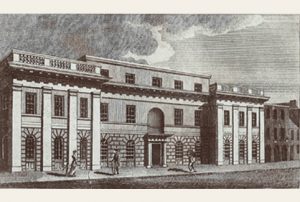
In the years after its formation, the RDS recognised the potential of agricultural land in Ireland, while also noting the lack of scientific education among Irish farmers. Their stated aims were the “promotion of Husbandry, manufacture and other arts and sciences,” and the Society pursued these goals in various ways, not least of which was their opening of the first agricultural museum in Britain and Ireland. In concerning itself with both agriculture and education, the museum illuminates a great deal about the tensions and ambiguities which existed between the RDS as an ‘Irish’ institution, and its members’ residual relationship with Britain and the Empire. On the one hand, this attempt to encourage the more efficient use of land through scientific education obviously served the economic interests of Ascendancy landholders. However, the effects of this increased efficiency could not fail to benefit wider Irish society as improved knowledge of the science of agriculture would also yield greater returns for the rural population in general whether Catholic or Protestant. This attempt to improve the lot of the rural population in an overwhelmingly rural country can also be viewed as an attempt to imbue the populace with a greater sense of pride in the very soil of the nation itself.
The Dublin Society Act of 1792 directed the RDS to utilise all future funds for the acquisition of natural history specimens, botanical collections and materials for the newly established drawing school. In addition, and most significantly, the use of government grants (which made up ninety percent of the RDS’s funding) for agricultural endeavours was to desist. Little information is to be found as to the exact motivations for this redistribution of funds, but it can be argued that this was a tactical move intended to suppress Irish industrial endeavours and undermine territorial ambitions. However, the passing of this act instead serves to illustrate further the tangled web of political and social contradictions woven into the Ireland of the late eighteenth century. The 1780s and 1790s were a period of intense political turmoil. In Ireland, this was exemplified most clearly in the debates around the ‘Catholic question,’ and the challenge posed by increasing Catholic agency to Ascendancy social dominance. Anglo-Irish anxieties were intensified in the context of the establishment of groups such as the United Irishmen (1791) and the revolution in France. Calls for greater concessions to Catholics fell on deaf ears in Dublin where a meagre Catholic Relief Act was passed in 1792, and proved so unsatisfactory that a further Act had to be passed one year later. The Act sought not only to undermine the RDS’s activities, but also to undermine a society which by the nature of its self-government had attempted to assert its institutional independence in a manner which perhaps appeared dangerously revolutionary.
Having been eroded by the Dublin Society Act, the independence enjoyed by the RDS throughout the eig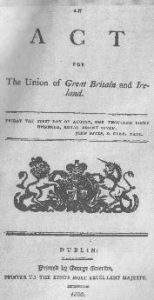 hteenth century was finally brought to an end by the Act of Union. While the negative effects of this Union in almost all quarters of Irish society are well documented, the RDS was interestingly at odds with this trend, and despite a curtailment in subscriptions to societies it flourished during the nineteenth century. The acquisition of scientific specimens was taken up with renewed vigour while exhibitions of these specimens proved extremely popular with the public. This popularity culminated in the pinnacle of their achievements in 1857 when the society opened its purpose-built Natural History Museum in Merrion Square. While this situation may appear rosy enough, these positive developments were more the result of a spirit of conformity on the part of the RDS rather than a wholesale surrender to British control. It would appear that the RDS accommodated itself to British oversight for its own gain. Through this relationship, the society formed close links with British museums and learned societies and relished the wealth of information this afforded.
hteenth century was finally brought to an end by the Act of Union. While the negative effects of this Union in almost all quarters of Irish society are well documented, the RDS was interestingly at odds with this trend, and despite a curtailment in subscriptions to societies it flourished during the nineteenth century. The acquisition of scientific specimens was taken up with renewed vigour while exhibitions of these specimens proved extremely popular with the public. This popularity culminated in the pinnacle of their achievements in 1857 when the society opened its purpose-built Natural History Museum in Merrion Square. While this situation may appear rosy enough, these positive developments were more the result of a spirit of conformity on the part of the RDS rather than a wholesale surrender to British control. It would appear that the RDS accommodated itself to British oversight for its own gain. Through this relationship, the society formed close links with British museums and learned societies and relished the wealth of information this afforded.
The RDS of the nineteenth century displayed an apparent willingness to function as a politically feeble establishment institution. This attitude persisted until 1877 when the Merrion Square museum and the entirety of its collections were absorbed into the British Department of Science and Art. This development not only revitalised the collection itself, but also reinvigorated the contentious questions surrounding Ireland’s political, social and cultural position within the Empire, which stemmed from those collections. Indeed, the nationalist Freeman’s Journal portrayed it as a territorial move on the part of the British government:
“The settled passion of the Government appears to be to quietly obliterate the last traces of Irish nationality…and to root out every Irish institution.”
Despite the absence of any apparently overt political activity on the part of the nineteenth-century RDS, the Society had still come to be regarded as an ‘Irish institution’ which not be should be subsumed into a broader British administrative framework. Indeed from the opening of its doors in 1857, the Natural History Museum had been identified as the ‘National Museum’ in contemporary casual commentary. This incorporation into a British government department clearly chafed against nationalist sentiment in the country, and immediately politicised the collection. This politicisation is even more remarkable when we remember that the only change was one of administrative control while the objects themselves remained firmly in place, never leaving their home in Merrion Square. Though there remained some years to go until the amalgamation of this collection with that of the Royal Irish Academy, the political and cultural complexities inherent in these collections were therefore already present in embryo in 1877, and would begin a rapid gestation from 1890 onwards.
The Royal Irish Academy
The Royal Irish Academy emerged from the eighteenth century revival as an institution much akin to the RDS in its early sentiment. Where the RDS sought to improve agriculture and industry in order to put Ireland on a more equal footing with Britain, the RIA sought to establish a similar status through Irish intellectual endeavour. Tired of being regarded as scholarly subordinate, Irish intellectuals conspired to compete with and even surpass in their contribution to European artistic and scientific development. The RIA were much more overtly cultural in its endeavours than the RDS and indeed more avowedly ‘Irish’ with its study of manuscripts, folklore, Celtic settlements and archaeological sites. Like the RDS, the RIA of the eighteenth century was pro-legislative independence. In contrast however, the Academy was marginally more pluralist, with a number of Catholic members. Though during the nineteenth century the RIA was perceived to be an officially apolitical institution, its eighteenth-century character pointed to a vested interest in Patriot politics. This political persuasion is evidenced by the election of James Caulfield, Earl of Charlemont as the first president of the Academy. He had played a significant role in Ireland’s legislative independence in 1782 and was also a friend and patron of Henry Grattan. Charlemont also provided one of the earliest examples of the RIA’s use of scholarship and antiquarianism for political ends when he sought to argue against the suppression of the Irish woollen industry through a paper published in the RIA’s journal which charted the antiquity of that industry in the country. In light of these characteristics it is perhaps surprising that in contrast to the RDS, the RIA does not appear to have suffered the same challenges to its functions brought on by the Act of Union. Presumably, from the perspective of the British government, studies of the Fianna and fairy folk appeared less existentially threatening than the agricultural and industrial innovations promoted by the RDS. However, as an organisation interested in effecting a Celtic renaissance through the study of a Gaelic past that was distinct from Britain, both historically and culturally, the RIA’s activities were perhaps even more radically political than those of the RDS, a radicalism which would only increase with the expansion of their antiquarian collections during the nineteenth century.
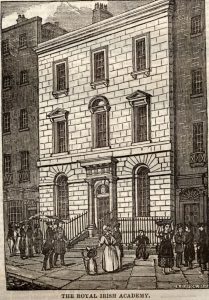
The museums established by the RDS and the RIA in the nineteenth century also serve as illustrative counterpoints in the politics of display. In addition to the RDS’s museums of agriculture and natural history already discussed above, the RIA also sought to disseminate that knowledge of a Gaelic past which had been generated through its scholarship. The Academy had noted as early as 1842 that it aspired to ‘establish a Museum – the only truly national one – for the benefit of this country.’ This aspiration came closer to realisation when the RIA’s premises on Dawson Street was transformed into a functioning museum in 1852. This museum’s exhibitions were similar to those of the RDS in being staged for the purposes of public education, albeit with contrasting aims. Where the RDS utilised its collection to both promote and underpin the dominant role of the Protestant Ascendancy in Ireland, the RIA’s collections sought to revive and glorify a knowledge of the ‘Celtic’ past. In this way, the members of the Academy were acting in a manner reminiscent of those early Christian missionaries with whose writings and material objects they were so enamoured. This zealous and proselytising spirit was perhaps a reaction to a sense of existential crisis in an Ireland where by 1848 the Irish language had become ‘the mark of poverty, illiteracy and social backwardness,’ and which had been wracked by years of famine, death and mass emigration. By providing evidence for the existence of a vibrant Irish culture which stretched back centuries, the RIA was perhaps also attempting to inculcate a sense of the Irish as a resilient people. By amassing and displaying objects which drew on the whole sweep of the island’s past, the RIA were using their collection to serve contemporary political and social needs, a practice which reflected their desire to become a ‘national’ institution and which would characterise their activities until their collection’s ultimate amalgamation with that of the RDS in the National Museum of Ireland. The objects themselves therefore bear some further analysis. First, however, it is necessary to offer some comments on the motivations of the individual responsible for some of their most important acquisitions: George Petrie.
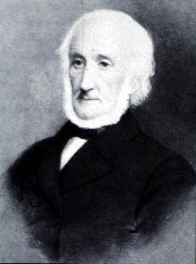
Petrie became a member of the Academy’s council in 1829. Passionate about the study of Ireland’s ‘ancient civilisation and early colonisation,’ he argued for the existence of a ‘settled Irish society’ which held close the values of its early pagan heritage. Named the ‘linchpin of the Celtic revival’ by Hutchinson, Petrie dedicated himself to the RIA’s antiquarian and archaeological collection, and aspired to establish a collection that was wholly Irish in character. Though the acquisition of such material surely carried political overtones, Petrie himself viewed this as an entirely aesthetic and intellectual endeavour. In his commentary on the Tara Brooch, Petrie emphasised its artistic qualities and took them as evidence which ‘would dispel any doubt about the state of development of Ireland in earlier times.’ However, we can hardly ignore the uses to which the brooch would be put as an icon by later political activists in service of overtly nationalist aims. A similar process was at play in the case of the Cross of Cong. Once again its acquisition stemmed from Petrie’s desire to collect objects of ‘national’ importance. However, regardless of whatever aesthetic or scholarly interests may have prompted Petrie to acquire this particular object, we cannot fail to note the overwhelmingly political nature of a reliquary commissioned by the last High King of Ireland, which was said to have housed a fragment of the True Cross. In this way, the RDS and RIA can be argued to be imbued with the political and cultural ambiguities characteristic of the man himself. Though largely unconcerned with politics, Petrie was still at bottom a patriotic unionist and had no separatist sympathies to speak of. On the other hand, he did seek to promote an interest in all things national and in doing so his work – much like the objects he collected – could easily be turned to overtly nationalist purposes regardless of his own original intention.
By 1868 the RIA’s museum was becoming increasingly difficult to maintain due to the size of its collections and their public appeal. As a result, a proposal was sent to Westminster requesting the establishment of a dedicated museum of science and art. It is only at this moment of their request for a purpose-built repository that significant tensions first emerged between the Academy and the government. The request for a new museum thus prompted the establishment of a Committee of Enquiry in 1868 which raised concerns with regard to the public nature of this private organisation and resented its distinctly Irish character. Though the enquiry ultimately decided that it was necessary to establish a museum of science and art, this would be done under the direction of the British civil service despite recommendations by RIA members to the contrary. Thus in return for the establishment of this repository, the Academy would be required to turn its collection over to government ownership. Though the actual transfer would not take place until 1890, the RIA’s collections were essentially a state collection from 1868. Though the government’s apparently anti-Irish reaction to the Academy’s request must certainly have come as a shock to its members, it nevertheless relieved the RIA of a burden which it could no longer carry. In this way, the RIA’s treasure trove was incorporated into the cultural collections of the establishment in a manner more quiescent and even accidental than had been the case with the RDS. However, of the two societies, the RIA can be said to have bequeathed by far the more politically charged collection. In contrast to the RDS’s less readily politicised scientific specimens, the RIA left a legacy of tangible evidence for an island heritage that was distinctly Irish. Thus, given their status as the foundation stones for the collections which would eventually form the patrimony of the National Museum of Ireland, the holdings of the RDS and RIA left the nascent National Museum with the question of whether its collection was ultimately ‘national’ or ‘nationalist’.
The Museum of Science and Art
1890 witnessed the establishment of the Dublin Museum of Science and Art which amalgamated the holdings of the RIA and the natural history specimens housed in Merrion Square. Though it would be several years yet before the Dublin museum officially acquired the ‘National’ title, and though it has today expanded to two other sites – namely Collins Barracks in Dublin and Turlough Park in Co. Mayo – the embryo of the National Museum can reasonably be said to have been conceived through the union of these two societies’ respective collections. It is unsurprising that the National Museum of Ireland today retains an air of political ambiguity when one analyses the complexities surrounding the institutions which formed the basis of its contemporary collections. The Museum stands today as an emotionally-charged reminder of both Britain’s imperial project and the dominance of a small elite within Irish society, but also of the extent to which that elite contributed to the character of modern Ireland. We can therefore see that Dr Wallace’s sentiments ring true, and that by seeking to understand more about the genesis of the National Museum in the form of the RDS and the RIA, we come closer to understanding the Ireland of today.

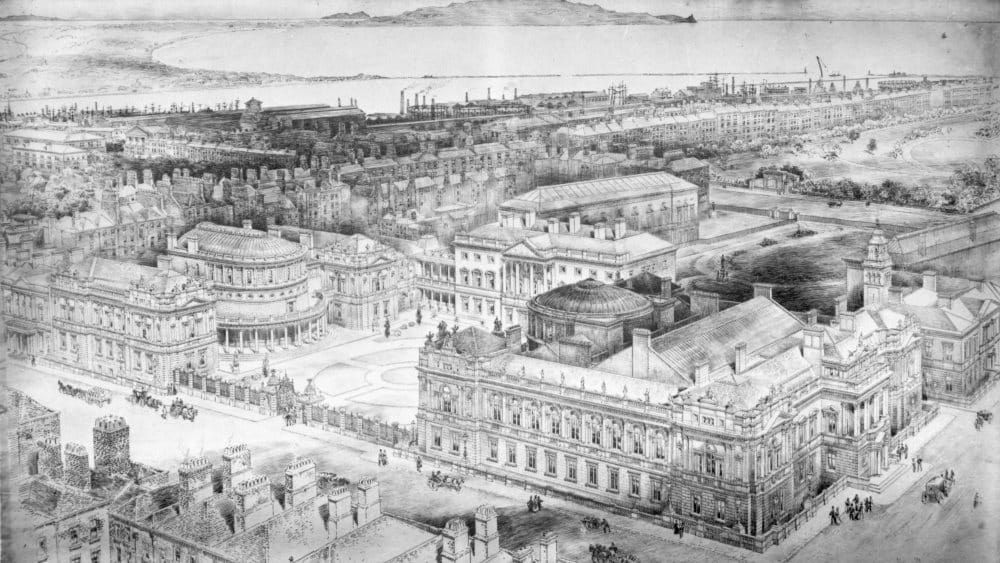
There is certainly a great deal to know about this subject.
I love all of the points you’ve made.
obviously like your website but you have
to check the spelling on quite a few of your posts.
A number of them are rife with
spelling problems and I to find
it very bothersome to tell the reality then again I’ll certainly come again again.
This is very interesting
Have you ever thought about adding a
little bit more than just your articles?
I mean, what you say is fundamental and everything.
Nevertheless just imagine if you added some great pictures
or videos to give your posts more, ?pop?! Your content is excellent but with
pics and video clips, this website could definitely be one of the best in its field.
Terrific blog!
Great suggestion, thank you, Dirk.
After looking into a
number of the blog articles on your website, I honestly
like your way of writing a blog.
I saved as a favorite
it to my bookmark website list and will
be checking back in the near future. Please visit my web site too and tell me what you think.
Trust me, you have to write regularly. We need a lot more articles similar to this one.
Fantastic website. Lots of helpful info here. I’m sending it to several friends ans additionally sharing in delicious. And of course, thanks to your sweat!